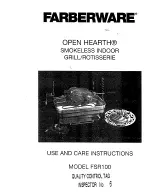
TFTN 085-199 Installation and Operation Manual
15
4.0 GENERAL VENTING
The TFTN is certified as a
“Category IV”
boiler
requiring a “Special Venting System” designed for pressurized venting.
The
Exhaust must be piped to the outdoors, using the vent materials and rules outlined in this section. Under no conditions may
this unit vent gases into a masonry chimney, unless it is vacant, and utilizes the approved venting material and rules
described in this section.
The venting system shall be installed in accordance with the instructions contained within this
document and, if applicable, the venting system manufacturer’s inst
ructions. Failure to properly
install the venting system may result in flue gas spillage or recycling, causing property damage,
personal injury, or death.
Exhaust and Air Intake are to be piped separately. The TFTN cannot share a common vent or air
intake with multiple boilers
unless the common venting system has been certified by NTI (Contact
NTI for details).
Failure to comply will result in serious injury or death.
4.1
Removing an Existing Boiler from Common Venting System
Do not install the TFTN into a common venting system with any other boiler. Failure to comply
with this warning will cause flue gas spillage and leech carbon monoxide emissions into the
surrounding air resulting in serious injury or death.
When an existing boiler is removed from a common venting system, the common venting system
is likely to be too large for proper venting of the remaining boilers connected to it. Instructions
have been provided on how to remove the existing boiler and how to resize the remaining venting
system. Failure to follow these instructions may result in property damage, serious injury or death.
Upon removal of an existing boiler, the following steps shall be followed for each boiler remaining in the common venting
system; prior to commencing this procedure, shutdown all boilers remaining in the common venting system.
Steps to Removing an Existing Boiler:
1.
Seal any unused openings in the common venting system.
2.
Visually inspect the venting system for proper size and horizontal pitch. Verify that there is no blockage, restriction,
leakage, corrosion, or other deficiencies which could cause an unsafe condition.
3.
Insofar as is practical, close fireplace dampers, all building doors and windows and all doors between the space in which
the boilers remaining connected to the common venting system are located and other spaces of the building. Turn on
clothes dryers and any boiler not connected to the common venting system. Turn on any exhaust fans, such as range
hoods and bathroom exhausts, so they will operate at maximum speed. Do not operate a summer exhaust fan.
4.
Place in operation the boiler being inspected. Follow the applicable lighting instructions. Adjust thermostat so boiler
will operate continuously.
5.
Test for spillage at the draft hood relief opening after 5 minutes of main burner operation. Use the flame of a match or
candle, or smoke from a cigarette, cigar, or pipe.
6.
After it has been determined that each boiler remaining connected to the common venting system properly vents when
tested as outlined above, return doors, windows, exhaust fans, fireplace dampers and any other gas burning boiler to
their previous condition of use.
7.
Any improper operation of the common venting system should be corrected so the installation conforms to the National
Fuel Gas Code, ANSI Z223.1/NFPA 54 and/or CAN/CSA B149.1, Natural Gas and Propane Installation Code. When resizing
any portion of the common venting system, the common venting system should be resized to approach the minimum
size as determined using the appropriate tables in Part 11 of the National Fuel Gas Code, ANSI Z223.1/NFPA 54 and/or
CAN/CSA B149.1, Natural Gas and Propane Installation Code.
4.2
Combustion Air Intake Contamination
Be careful not to locate the air intake termination in an area where contaminants can be drawn in and used for combustion.
Combustion air containing dust, debris or air-borne contaminants will drastically increase the required maintenance and
may cause a corrosive reaction in the Heat Exchanger which could result in premature failure, fire, serious injury, or death.
See Table 4-1 for a list of areas to avoid when terminating air intake piping:
















































